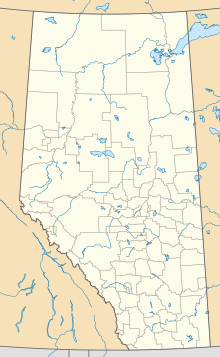Zama City
Zama City | |
|---|---|
Location of Zama City in Alberta | |
| Coordinates: 59°09′06″N 118°42′21″W / 59.15176°N 118.70590°W | |
| Country | Canada |
| Province | Alberta |
| Census division | No. 17 |
| Specialized municipality | Mackenzie County |
| Government | |
| • Type | Unincorporated |
| • Reeve | Peter F. Braun |
| • Governing body | Mackenzie County Council
|
| Area (2021)[1] | |
| • Land | 21.68 km2 (8.37 sq mi) |
| Elevation | 320 m (1,050 ft) |
| Population (2021)[1] | |
| • Total | 52 |
| • Density | 2.4/km2 (6/sq mi) |
| Time zone | UTC−7 (MST) |
| • Summer (DST) | UTC−6 (MDT) |
Zama City is a hamlet in northwestern Alberta, Canada within Mackenzie County.[2]
It is located north of Zama Lake along Zama Road, which branches off the Mackenzie Highway (Highway 35) approximately 80 kilometres (50 mi) north of High Level.
The hamlet is located in Census Division No. 17 and in the federal riding of Grande Prairie-Mackenzie.
Demographics
[edit]In the 2021 Census of Population conducted by Statistics Canada, Zama City had a population of 52 living in 24 of its 27 total private dwellings, a change of -29.7% from its 2016 population of 74. With a land area of 21.68 km2 (8.37 sq mi), it had a population density of 2.4/km2 (6.2/sq mi) in 2021.[1]
As a designated place in the 2016 Census of Population conducted by Statistics Canada, Zama City had a population of 74 living in 34 of its 61 total private dwellings, a change of -20.4% from its 2011 population of 93. With a land area of 21.68 km2 (8.37 sq mi), it had a population density of 3.4/km2 (8.8/sq mi) in 2016.[12]
Economy
[edit]It is based mainly around the oil and gas industry. A major oil pipeline connects Zama City with Norman Wells in the Northwest Territories.
Transportation
[edit]Two airstrips serve the community, Zama Airport (CEX5) and Zama Lake Airport (CFT9).
See also
[edit]References
[edit]- ^ a b c d "Population and dwelling counts: Canada and designated places". Statistics Canada. February 9, 2022. Retrieved February 10, 2022.
- ^ "Specialized and Rural Municipalities and Their Communities" (PDF). Alberta Municipal Affairs. June 3, 2024. Retrieved June 14, 2024.
- ^ 1971 Census of Canada: Population (PDF). Special Bulletin: Unincorporated Settlements. Vol. Bulletin SP—1. Ottawa: Statistics Canada. March 1973. Retrieved December 5, 2021.
- ^ "Geographical Identification and Population for Unincorporated Places of 25 persons and over, 1971 and 1976". 1976 Census of Canada (PDF). Supplementary Bulletins: Geographic and Demographic (Population of Unincorporated Places—Canada). Vol. Bulletin 8SG.1. Ottawa: Statistics Canada. May 1978. Retrieved December 5, 2021.
- ^ 1981 Census of Canada (PDF). Place name reference list. Vol. Western provinces and the Territories. Ottawa: Statistics Canada. May 1983. Retrieved December 5, 2021.
- ^ 1986 Census of Canada (PDF). Population. Vol. Unincorporated Places. Ottawa: Statistics Canada. July 1988. Retrieved December 5, 2021.
- ^ 91 Census (PDF). Population and Dwelling Counts. Vol. Unincorporated Places. Ottawa: Statistics Canada. June 1993. Retrieved December 5, 2021.
- ^ 96 Census (PDF). A National Overivew: Population and Dwelling Counts. Ottawa: Statistics Canada. April 1997. Retrieved December 5, 2021.
- ^ "Population and Dwelling Counts, for Canada, Provinces and Territories, and Census Divisions, 2001 and 1996 Censuses - 100% Data (Alberta)". Statistics Canada. August 15, 2012. Retrieved December 5, 2021.
- ^ "Population and dwelling counts, for Canada, provinces and territories, and designated places, 2006 and 2001 censuses - 100% data (Alberta)". Statistics Canada. July 20, 2021. Retrieved December 1, 2021.
- ^ "Population and dwelling counts, for Canada, provinces and territories, and designated places, 2011 and 2006 censuses (Alberta)". Statistics Canada. February 8, 2012. Retrieved April 7, 2012.
- ^ a b "Population and dwelling counts, for Canada, provinces and territories, and designated places, 2016 and 2011 censuses – 100% data (Alberta)". Statistics Canada. February 8, 2017. Retrieved February 13, 2017.


 French
French Deutsch
Deutsch